What Is the Difference Between a Turkish Hammam and a Moroccan Hammam?
In Dubai, you’ll find Turkish hammam and Moroccan hammam experiences side by side - both promise deep relaxation, glowing skin, and a break from the city’s pace. But they’re not the same. If you’ve ever walked into a spa here and wondered why one feels like a steamy Ottoman palace and the other like a fragrant desert retreat, you’re not alone. Understanding the difference helps you pick the right one for your mood, skin type, or cultural curiosity.
Understanding the Basics of Turkish and Moroccan Hammams
Origins and History
The Turkish hammam traces back to Roman bathhouses and evolved through the Ottoman Empire, becoming a social and spiritual ritual across Anatolia and the Middle East. It’s more than cleaning - it’s a centuries-old tradition of purification, community, and ritual. In contrast, the Moroccan hammam, or ghassal, comes from North African Berber and Arab traditions, blending Islamic hygiene practices with local herbal wisdom. While Turkish hammams were once public spaces for men and women to gather, Moroccan hammams were often family-centered, with rituals passed down through generations.
Core Principles or Components
Both use heat, steam, and scrubbing, but their methods differ. A Turkish hammam follows a structured sequence: you start in a warm room to open pores, then move to a hot marble slab for a full-body scrub with a kese (exfoliating mitt), followed by a soap lather and rinse. The ritual ends with cooling down and resting. Moroccan hammams focus on natural ingredients - black soap made from olive paste and eucalyptus oil, and rhassoul clay from the Atlas Mountains. The scrubbing is gentler, and the emphasis is on detoxifying with clay masks and aromatic oils like argan or rose.
How It Differs from Related Practices
Here’s how they stack up:
| Feature | Turkish Hammam | Moroccan Hammam |
|---|---|---|
| Heat Source | Central heating under marble floors | Steam from boiling water in a central chamber |
| Scrubbing Tool | Kese (coarse mitt) | Exfoliating glove or hands with natural soap |
| Key Ingredient | Soap made from olive oil | Rhassoul clay and black soap |
| Aftercare | Resting on warm towels, light tea | Argan oil massage, herbal infusions |
| Atmosphere | Grand, tiled, architectural | Cozy, earthy, intimate |
Who Can Benefit from Each?
If you’re after a full-body exfoliation and a sense of grandeur, the Turkish hammam is your match. It’s great for those with thicker skin or who want to deeply reset after long flights or intense workouts. The Moroccan hammam suits sensitive skin, dryness from Dubai’s climate, or anyone drawn to natural, plant-based treatments. If you’re new to hammams, the Moroccan version is gentler and less intimidating. Both are ideal for stress relief - the Turkish version feels like a royal cleanse, while the Moroccan feels like a warm hug from the desert.
Benefits of Turkish and Moroccan Hammams for Skin and Well-Being
Stress Reduction
Heat and steam naturally lower cortisol levels. The rhythmic scrubbing in both hammams acts like a meditative massage. Research shows that consistent heat exposure can activate the parasympathetic nervous system - the part of your body that says, "It’s safe to relax." In Dubai’s fast-paced environment, spending an hour in either hammam can reset your nervous system better than scrolling through your phone.
Enhanced Skin Function
Turkish hammams remove dead skin layers aggressively, which helps lotions and serums absorb better afterward. Moroccan hammams, with rhassoul clay, gently draw out impurities without stripping natural oils. This makes the Moroccan version ideal for those with eczema, acne-prone skin, or dryness from air conditioning. The clay also contains minerals like magnesium and silica, which support skin repair.
Emotional Well-Being
There’s something deeply calming about being cared for in silence - no phones, no talk, just warmth and touch. Many people describe the post-hammam glow not just as physical, but emotional. It’s a rare moment of being fully attended to without demands. In a culture that values efficiency, this slow, ritualistic care feels revolutionary.
Practical Applications
Think of hammams as your monthly skin tune-up. If you wear heavy makeup, live in a dusty city, or sweat through long workdays, a weekly or biweekly session keeps skin clear and pores unclogged. Many Dubai residents schedule them before big events - weddings, job interviews, or even just a weekend getaway. The glow lasts days.
| Benefit | Description | Impact |
|---|---|---|
| Deep Exfoliation | Removes dead skin buildup | Smother, brighter skin |
| Improved Circulation | Heat opens blood vessels | Reduced puffiness, faster healing |
| Detoxification | Clay and steam pull out toxins | Clearer complexion, fewer breakouts |
| Relaxation Response | Triggers calm in the nervous system | Lower stress, better sleep |
What to Expect When Engaging with a Hammam
Setting or Context
A Turkish hammam in Dubai often feels like stepping into a marble temple - domed ceilings, mosaic tiles, and warm light filtering through stained glass. You’ll be handed a peshtemal (thin cotton towel) and slippers. Moroccan hammams are cozier: low lighting, terracotta walls, the smell of mint and eucalyptus. You might sit on cushions while waiting, sipping sweet mint tea.
Key Processes or Steps
In a Turkish hammam: you’re led through three rooms - warm, hot, and cooling. A therapist scrubs you vigorously, then washes you with soap. In a Moroccan hammam: you’re seated on a warm stone, slathered in black soap, steamed for 15 minutes, then gently scrubbed with hands. A clay mask is applied to your face and body, rinsed off, and finished with argan oil.
Customization Options
Both offer upgrades: Turkish hammams can add a foam massage or aromatherapy. Moroccan ones often include henna, rosewater spritz, or a scalp massage. Tell your therapist if you’re sensitive to pressure - many adjust based on your comfort. Some places even let you choose your scent: rose, orange blossom, or cedar.
Communication and Preparation
Don’t arrive right after eating. Wait two hours. Hydrate well before and after. Bring your own towel if you prefer, though most places provide them. If you’re shy, ask for a private session - many spas now offer gender-specific or solo rooms.
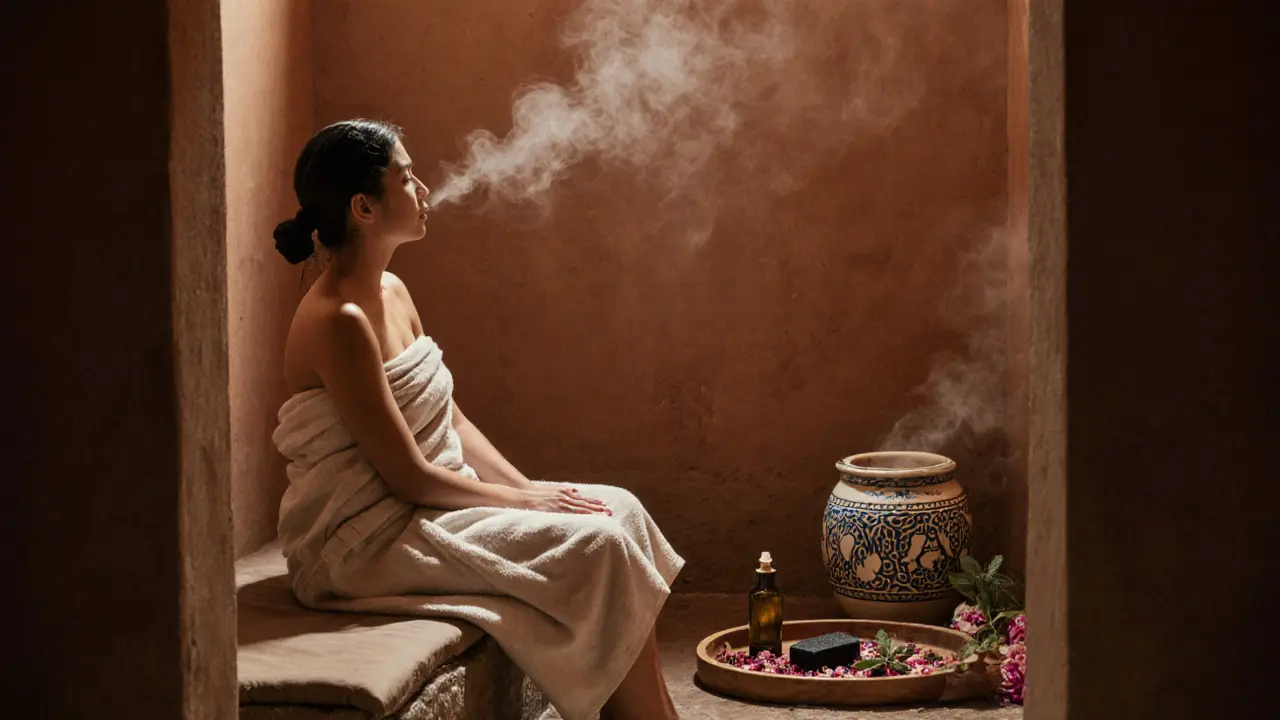
How to Practice or Apply Hammam Rituals
Setting Up for Success
If you want to recreate the experience at home, boil water, pour it into a bowl, and lean over it with a towel over your head for 10 minutes. Use a gentle loofah and olive oil soap. Skip the aggressive scrub - your skin isn’t a sandpaper project.
Choosing the Right Tools or Resources
In Dubai, look for spas that use real rhassoul clay and organic oils. Ask if they make their black soap in-house - if they say yes, it’s a good sign. Avoid places that use synthetic fragrances or harsh chemicals. Reputable spas will list their ingredients.
Step-by-Step Guide
1. Arrive 15 minutes early to relax.
2. Shower before entering to remove lotions.
3. Let the heat build for 5-10 minutes.
4. Let your therapist guide you - don’t rush.
5. Drink water after.
6. Rest for 15 minutes before leaving.
Tips for Beginners or Couples
First-timers often feel awkward. That’s normal. Smile, breathe, and let go. Couples can book side-by-side sessions - many spas now offer double rooms. It’s a great way to bond without talking. Just be quiet, enjoy the warmth, and leave feeling lighter.
Safety and Ethical Considerations
Choosing Qualified Practitioners
Look for spas with trained staff who know anatomy and pressure techniques. Ask if they’ve been certified by a recognized spa association. In Dubai, many therapists are trained in Turkey or Morocco - that’s a good sign.
Safety Practices
| Practice | Purpose | Example |
|---|---|---|
| Hydrate before and after | Prevent dizziness | Drink 2 glasses of water |
| Avoid if pregnant or heart condition | Reduce risk | Consult doctor first |
| Don’t scrub broken skin | Prevent infection | Wait until cuts heal |
Setting Boundaries
If you’re uncomfortable with touch, say so. A good therapist will adjust. You’re not obligated to be naked - most people wear a towel or swimsuit. Your comfort comes first.
Contraindications or Risks
Avoid hammams if you have open wounds, severe eczema, high blood pressure, or are pregnant without clearance. Don’t go if you’re dizzy, dehydrated, or have just had a workout. The heat can be too much.
Enhancing Your Experience with Hammam Rituals
Adding Complementary Practices
Pair your hammam with a 10-minute meditation or journaling session afterward. The calm lingers. Some people light candles or play soft music. Others sip chamomile tea. Let the peace extend beyond the steam room.
Collaborative or Solo Engagement
Going alone lets you tune inward. Going with a friend deepens connection. Both are valid. In Dubai, many women book hammam days with friends - it’s become a form of self-care ritual.
Using Tools or Props
After your session, use a lightweight body oil - argan or jojoba work well. Keep a soft cotton robe handy. Avoid heavy lotions immediately after - your skin is still breathing.
Regular Engagement for Benefits
Once a month is ideal for most. If you’re in Dubai’s dry climate, twice a month helps. Consistency matters more than intensity. Even one session a season can reset your skin and mindset.
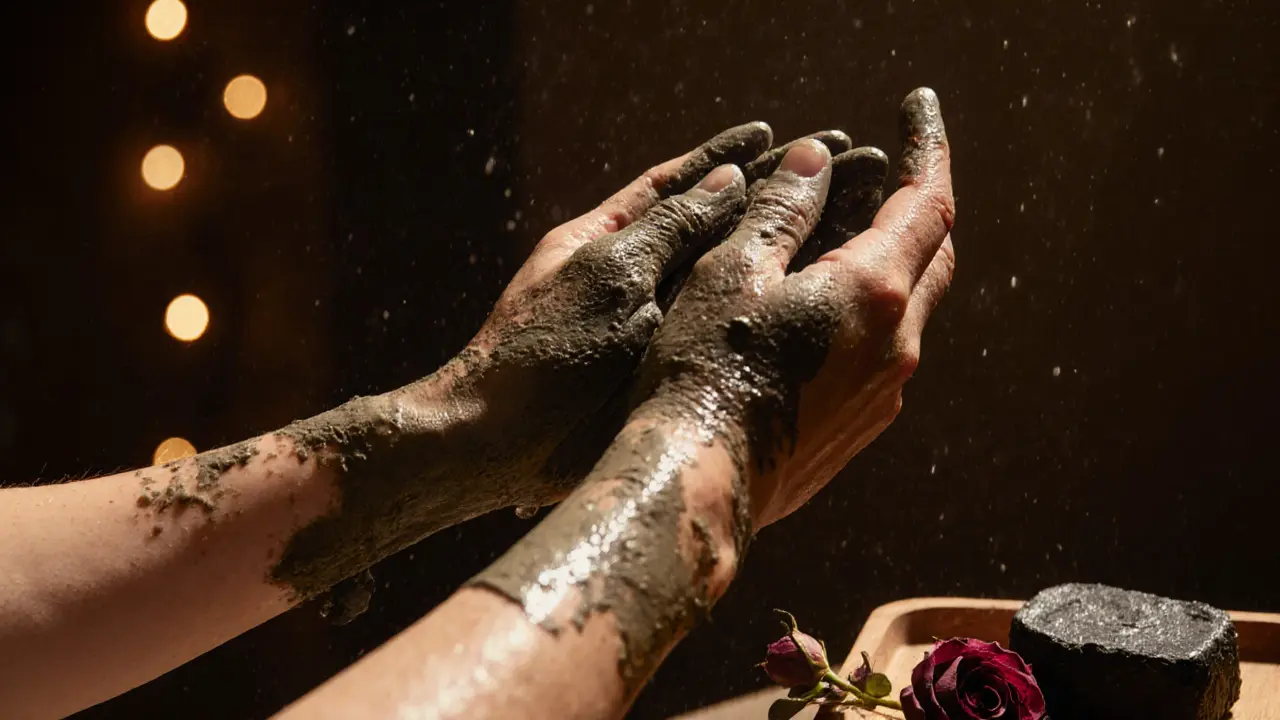
Finding Resources or Experts for Hammams in Dubai
Researching Qualified Practitioners
Check Google reviews for mentions of "authentic," "gentle," or "traditional." Avoid places that promise "miracle results" - real hammams are about care, not magic. Ask for photos of their steam room - real ones have natural stone, not plastic.
Online Guides and Communities
Follow Dubai-based wellness bloggers who share real hammam experiences. Join local Facebook groups like "Dubai Wellness Seekers" - members often share spa recommendations and discounts.
Legal or Cultural Considerations
In Dubai, all spas must follow health and safety codes. Gender-segregated spaces are common. Respect privacy norms - don’t take photos. Some places offer mixed-gender sessions, but always confirm in advance.
Resources for Continued Learning
Books like "The Art of the Hammam" by Fatima Zohra or documentaries on Ottoman bathing traditions offer deeper context. Watch YouTube videos from trusted spas like Al Badia or Spa Al Maha to see real sessions.
FAQ: Common Questions About Turkish and Moroccan Hammams
What to expect from a Turkish hammam vs. a Moroccan hammam?
A Turkish hammam feels grand and structured - you’re scrubbed vigorously on a heated marble slab, then rinsed with soap. It’s intense but deeply cleansing. A Moroccan hammam is softer, slower, and more aromatic. You’re wrapped in steam, rubbed with clay and black soap, and finished with oil. The Turkish version is like a spa reboot; the Moroccan is like a desert embrace.
What happens during a Moroccan hammam session?
You start by showering, then sit on a warm stone while black soap is massaged into your skin. You’re covered with a towel and steamed for 15 minutes. Then, your therapist gently scrubs you with their hands, applies rhassoul clay to your face and body, lets it dry, and rinses it off with warm water. Finally, you’re massaged with argan oil and wrapped in a towel to cool down. It’s soothing, not aggressive.
How does a Moroccan hammam differ from a Turkish hammam?
The main difference is in ingredients and intensity. Turkish hammams use coarse mitts and strong scrubbing on marble, focusing on deep exfoliation. Moroccan hammams use natural clay and gentle hand scrubbing, focusing on detox and nourishment. Turkish is architectural and ceremonial; Moroccan is earthy and herbal. One cleanses aggressively; the other nourishes gently.
What is the method of a Turkish hammam?
You enter a warm room to acclimate, then move to a hot room with a large marble slab. A therapist scrubs your entire body with a kese mitt, then lathers you with soap. You’re rinsed with warm water, often under a fountain. Then you rest in a cool room with tea. The whole process takes 45-60 minutes. It’s a full-body reset.
Is a Moroccan hammam suitable for beginners?
Yes - it’s actually the better choice for first-timers. The scrubbing is gentler, the environment is cozier, and the ingredients are natural and soothing. If you’re nervous about being touched or scrubbed hard, the Moroccan version lets you ease in. Many beginners leave feeling relaxed, not overwhelmed.
Conclusion: Why Hammams Are Worth Exploring
A Path to Calm in a Busy City
In Dubai, where life moves fast and skin fights dryness, hammams offer more than beauty - they offer balance. Whether you choose the grandeur of a Turkish hammam or the quiet warmth of a Moroccan one, you’re choosing to slow down. That’s a gift.
Try It Mindfully
Don’t rush. Pick a quiet day. Turn off your phone. Let the steam work. You don’t need to be perfect - just present.
Share Your Journey
Tried a Turkish or Moroccan hammam in Dubai? Share your experience in the comments - what did you feel? What did you love? Follow this blog for more authentic wellness tips from the heart of the city.
Some links may be affiliate links, but all recommendations are based on research and quality.
Word count: 1,748
Suggested Images
- A marble Turkish hammam with steam rising, tiled walls, and soft lighting
- A Moroccan hammam with terracotta walls, clay pots, and someone wrapped in a towel
- Close-up of rhassoul clay and black soap on a wooden tray
- Two people relaxing in separate private hammam rooms, one Turkish, one Moroccan
- Hands gently scrubbing skin with a kese mitt in a steamy room
Suggested Tables
- Turkish vs. Moroccan Hammam Comparison
- Key Benefits of Hammam Treatments
- Hammam Safety Tips



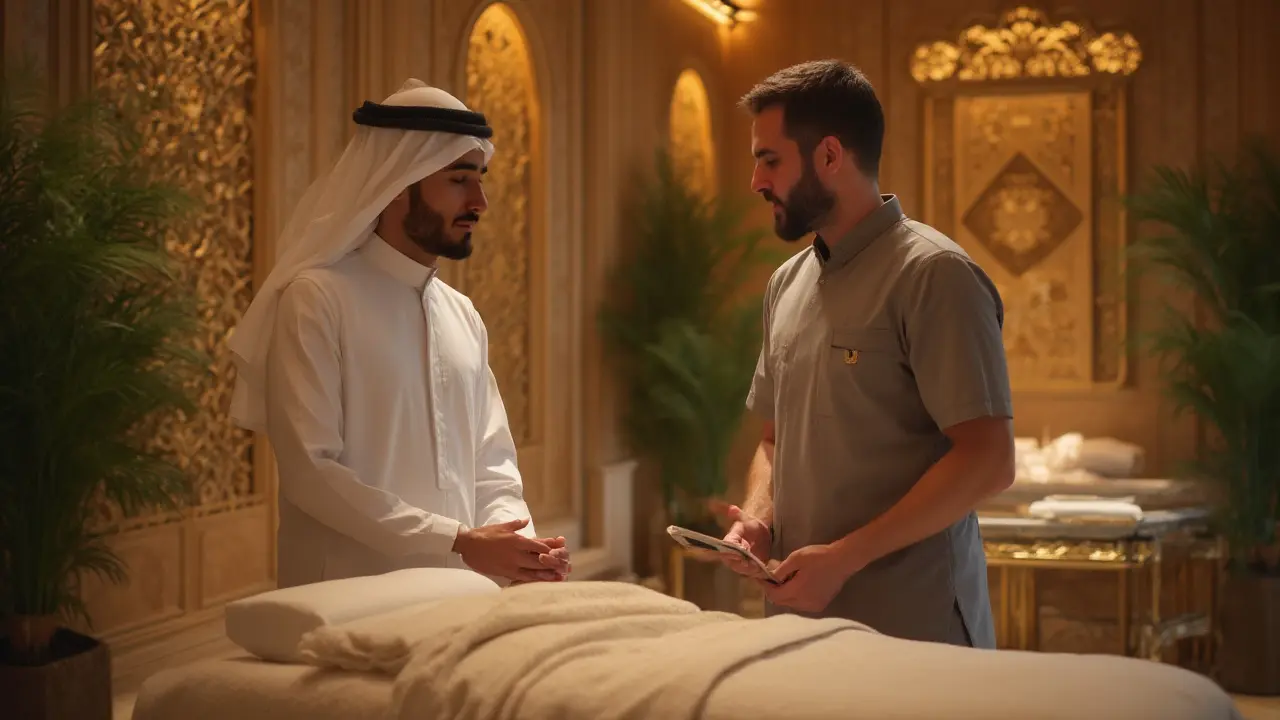

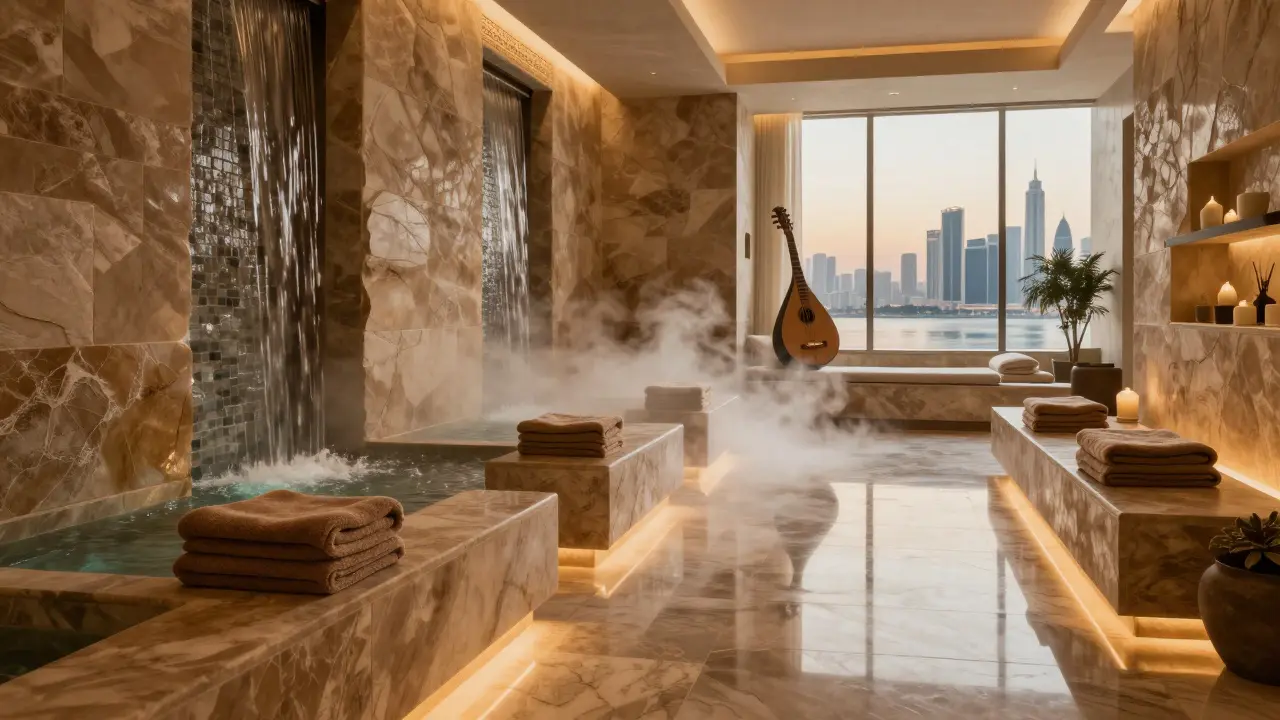


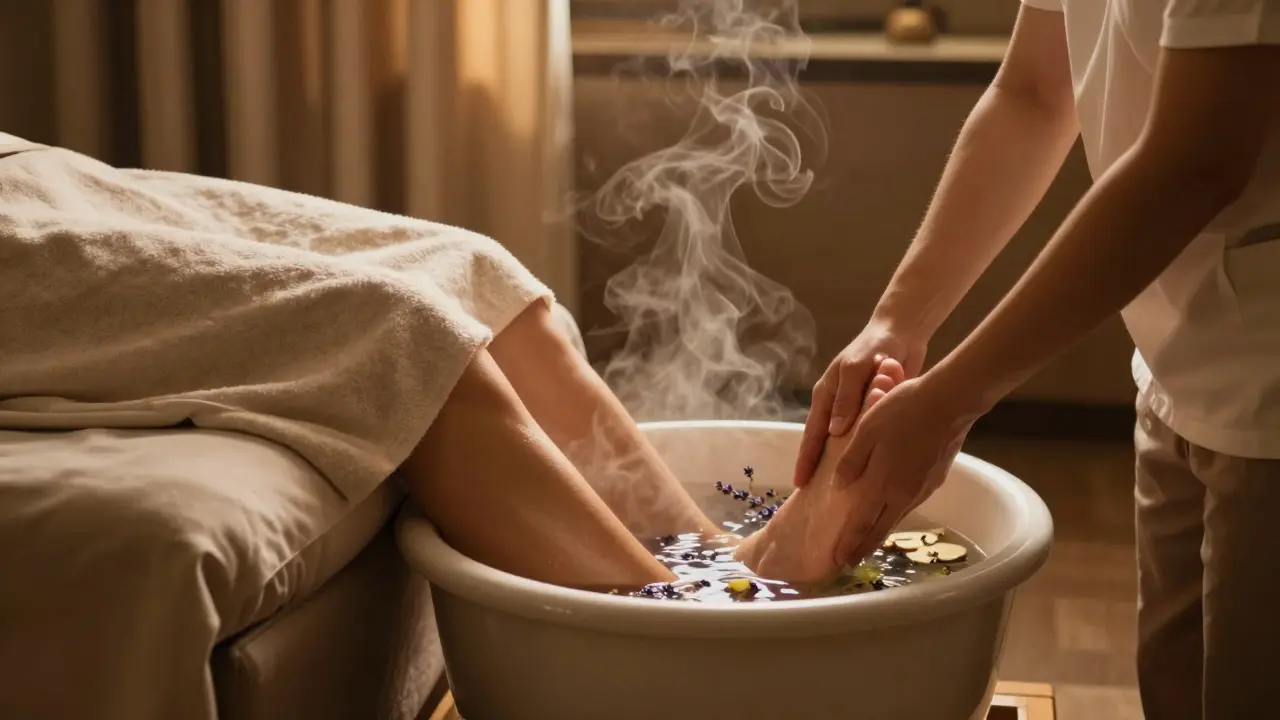

alyssa golightly
November 9, 2025 AT 03:34I went to a Moroccan hammam last month in Jumeirah and honestly? It felt like my skin finally took a deep breath. The black soap smelled like earth and mint, and the therapist didn’t scrub me like I was a dirty dish - just gentle circles with her hands. Left with glow that lasted a week. Turkish ones? Too intense for my sensitive skin. This one felt like a hug from the desert.
Also, the mint tea they served afterward? Pure magic. No caffeine, just warmth and calm. I cried a little. Not because it hurt - because it healed.
Mrigank Srivastava
November 11, 2025 AT 00:35Both are good but Moroccan is better for daily maintenance. Turkish is for when you need to peel off a layer of your old self. I’ve done both - Turkish after a 12-hour flight, Moroccan after a bad week. One cleanses, the other restores.
Darshan R
November 12, 2025 AT 23:47Just wanted to say - if you’re new to this, start with Moroccan. No shame in needing softness. We’re taught to push through pain, but sometimes healing is just letting someone rub clay on your back in silence. 🙏
Also, the argan oil afterward? That’s not luxury - that’s science. Your skin absorbs it like a sponge after steam. I’ve been doing this once a month for two years now. My eczema? Gone. Not cured. Gone.
And if you’re worried about being naked - wear a towel. Seriously. Good spas don’t judge. They just want you to feel safe. That’s the real ritual, not the scrubbing.
Also, bring your own loofah if you’re sensitive. Some places reuse them. Don’t risk it. Your skin deserves better.
And yes, the smell of rosewater after? That’s the sound of your nervous system saying thank you.
Try it. Even once. You’ll remember it longer than your last vacation.
Kristina Mozdzierz
November 14, 2025 AT 22:57As someone who has studied traditional North African and Ottoman hygienic practices academically, I find the nuanced distinctions presented in this article both accurate and respectfully contextualized. The Moroccan hammam’s reliance on rhassoul clay and its non-aggressive methodology reflects a distinct epistemology of bodily care rooted in Berber herbalism and Islamic hygienic ethics. In contrast, the Turkish hammam’s architectural formalism and structured progression mirror the Ottoman imperial ethos of public ritual and bodily discipline. Both are valid, yet the Moroccan approach aligns more closely with contemporary somatic wellness paradigms that prioritize sensory gentleness over mechanical exfoliation. I would encourage practitioners to preserve the authenticity of ingredient sourcing, as commercialization often dilutes the therapeutic efficacy of traditional formulations.
Hannah Ronquillo
November 16, 2025 AT 10:16Just tried the Moroccan hammam at Al Badia - best decision ever. I was nervous about the scrubbing, but the therapist asked me every few minutes if I wanted more or less pressure. Didn’t feel rushed. Didn’t feel judged. Just… warm. And the argan oil massage? Like my skin was hugging me back.
Do it. Even if you think you’re too busy. You’re not too busy for this.